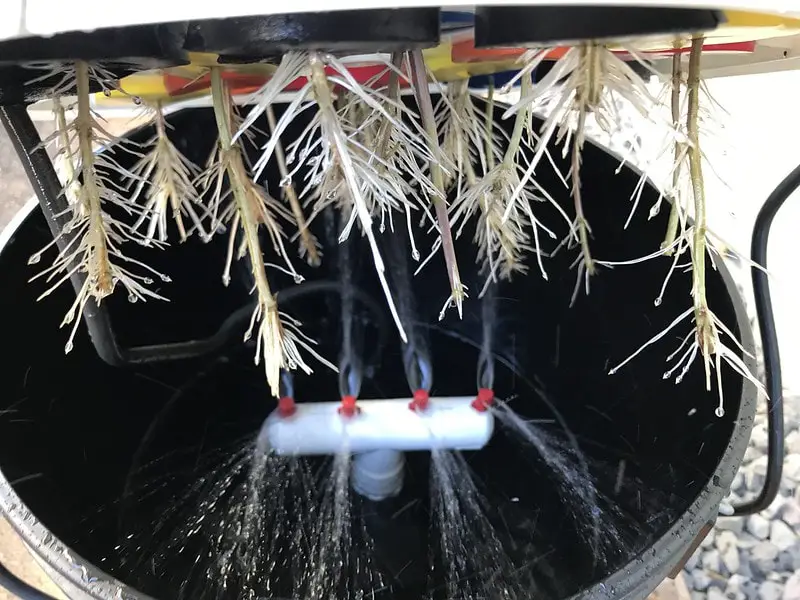In today’s article, we’ll be taking a look at Aeroponics:
A fairly complicated form of active hydroponics in which plant roots, held by a growing medium, are suspended in air above a nutrient solution reservoir and are misted at optimal time intervals for quick growth.
Aeroponic Advantages: 1.) Smaller nutrient water droplets means faster absorption by plant roots and faster plant growth overall. 2.) Less water and energy usage than traditional gardening and most other hydroponic techniques. 3.) Inexpensive. 4.) Little to no maintenance required overtime
Table of Contents:
How Do Aeroponic Systems Work?
The majority of hydroponic techniques function by supplying a steady stream of nutrient solution to plant roots.
Aeroponic systems, on the other hand, suspend plant roots above a growing reservoir (or tank) where they are then sprayed or misted with nutrient solution at specific time intervals. This requires a certain level of automation and is why aeroponics is considered to be the most technologically advanced form of hydroponics.
You see, there are three basic hydroponic techniques:
1.) Liquid Culture Hydroponics: A technique that implements an automated water pump and a reservoir tank to continuously provide plant roots liquid nutrient solution.
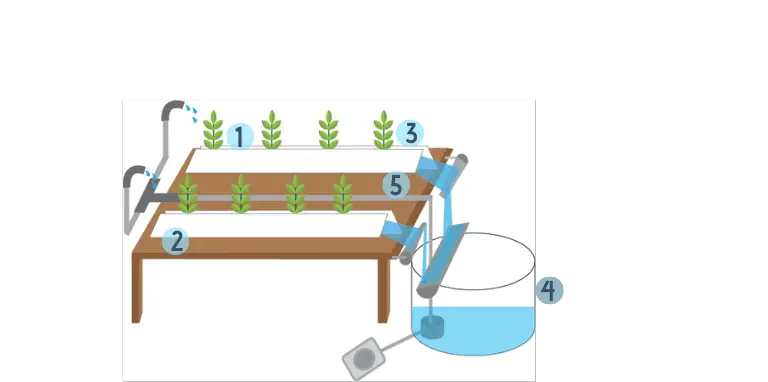
Notice how the nutrient solution is re-used and continuously pumped to the plant roots. This system requires upkeep, mainly monitoring the pH levels of the nutrient solution and sometimes re-supplying the system with fresh nutrient solution.
2.) Solid Media Culture Hydroponics: A technique that uses a solid medium (like gravel or rock wool) to hold plant roots in place and provide ample air and nutrient solution.
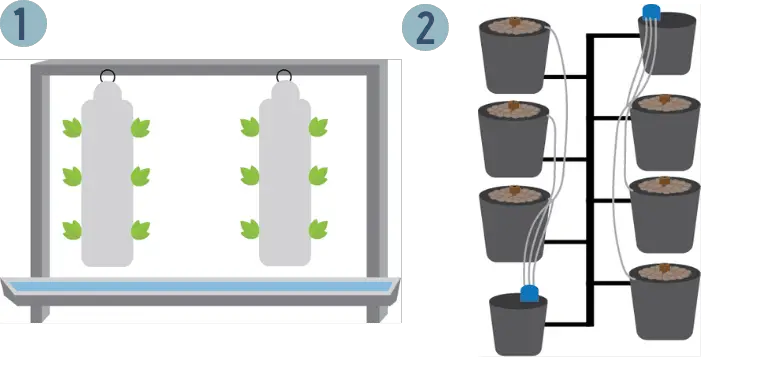
Keep in mind: The majority of hydroponic techniques use a solution tank and a pump.
But because Aeroponic systems operate by misting plant roots, they don’t require a large solution tank or an additional pump. In fact, they don’t require much space at all and are ideal for small vegetables, herbs, and spices.
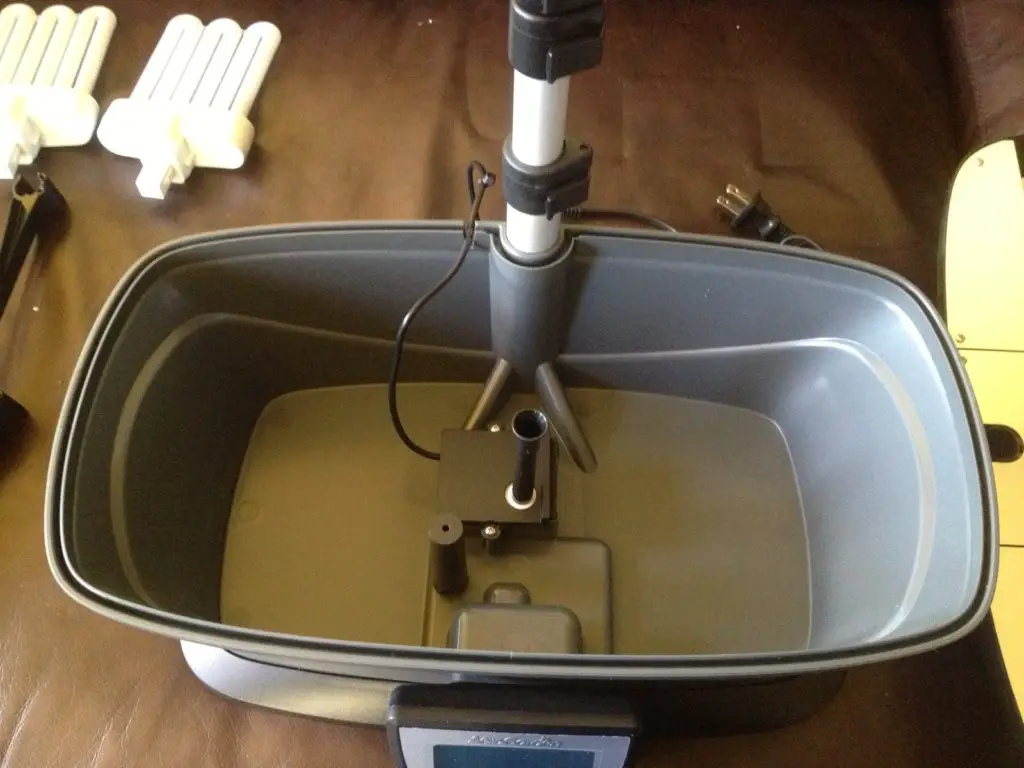
The picture above is from my older Aerogarden Bounty model – a classic automated aeroponic system. You can see the large built-in pump placed in the middle which is used for providing ample air and nutrient solution to plant roots.
Even older AeroGarden models – specifically the original 7 pod AeroGarden – used an aeroponic automated sprayer that targeted each individual plant pod.
It seems that AeroGarden found this technique to be too wasteful or energy inefficient and instead went with a single pump and a single sprayer.
Plant roots are suspended from these planting pods and placed into the unit:
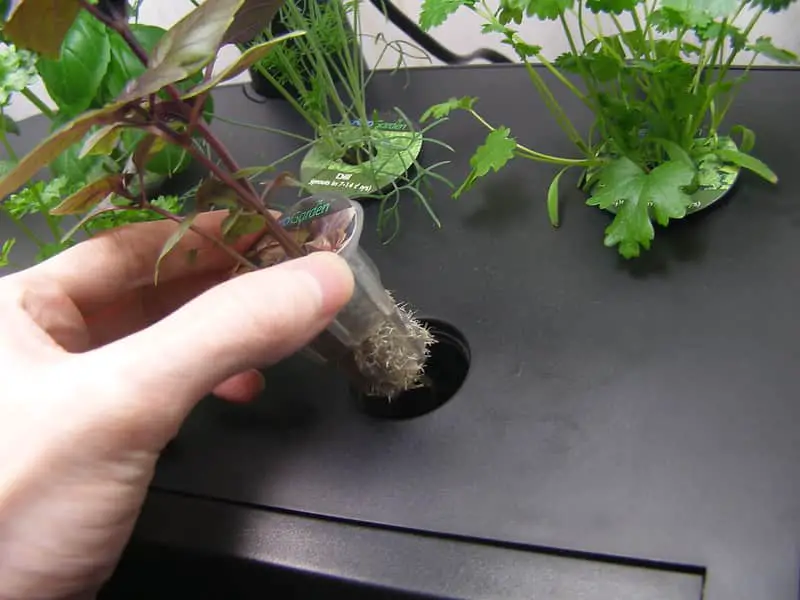
With aeroponics, the most important factor for plant growth and root development is the size of the average water droplet being delivered to plant roots.
If the average droplet is too large, then not enough oxygen is being provided to plant roots. If the average droplet is too fine, then plant roots won’t be provided the optimal amount of nutrients and may begin to wilt over time.
Most functional aeroponic units dispense water droplets that are between 30 – 90 microns.
Different Types of Aeroponic Systems
For the purpose of this article, we’re going to specifically focus on two different types of aeroponic systems:
| Technique | Type | Difficulty | Effectivenes |
|---|---|---|---|
| 1. Aeroponic Grow Unit | Aeroponics | 1/10 | 10/10 |
| 2. Fogponics | Aeroponics | 4/10 | 8/10 |
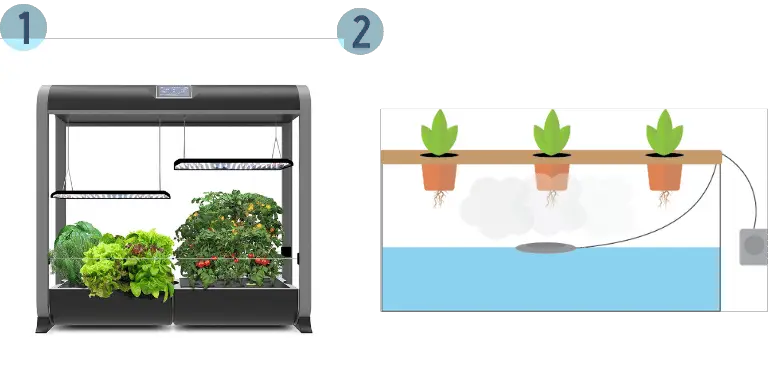
The first system on the left is the AeroGarden Farm, a fully automated aeroponic growing unit that can grow up to 24 plants at one time.
We recently published a detailed Aerogarden review article in which we cover the differences between each Aerogarden model.
For a quick recap, Aerogarden uses a nutrient solution reservoir – located towards the bottom of each unit – to spray the optimal amount of nutrient solution onto plant roots at very specific time intervals.
Aerogarden grow kits streamline aeroponics in a highly efficient way – you pick out your grow pods, you supply the unit with Aerogarden’s patented nutrient solution, you then use the LCD control panel to automate the rest.
| Model: | Grow Space: | LED Lights: | Value Score: |
|---|---|---|---|
| 1. AeroGarden Harvest | 6-pods | 20-watt | 98% |
| 2. AeroGarden Bounty | 9-pods | 40-watt | 96% |
| 3. AeroGarden Farm | 24-pods | 60-watt | 96% |
| 4. AeroGarden Sprout | 3-pods | 10-watt | 93% |
| 5. AeroGarden Farm Plus | 24-pods | 60-watt | 88% |
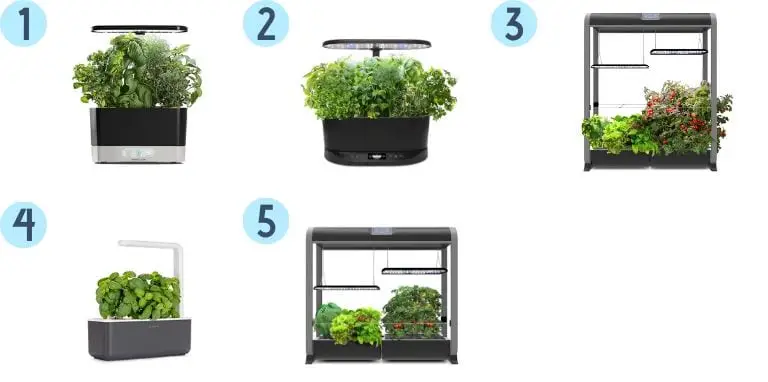
A quick look inside of the AeroGarden Bounty shows us just how well an automated aeroponics system can work.
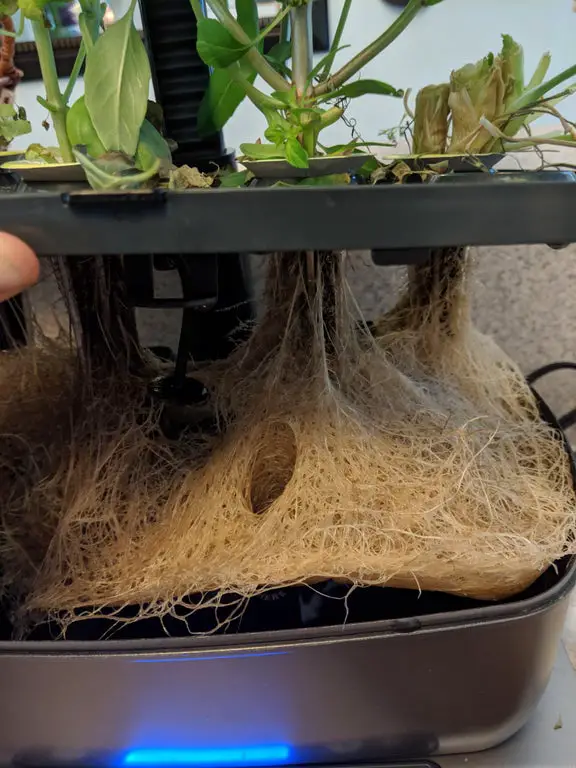
The roots are given ample space to grow, although, as you can see in the picture above, after just a few weeks plant roots can become seriously interwoven!
This actually isn’t a problem as the Aerogarden has sensors that can detect the amount of space plant roots are occupying and can adjust nutrient levels accordingly.
Fogponics, on the other hand, is a relatively new – and not very well established – aeroponic growing technique.
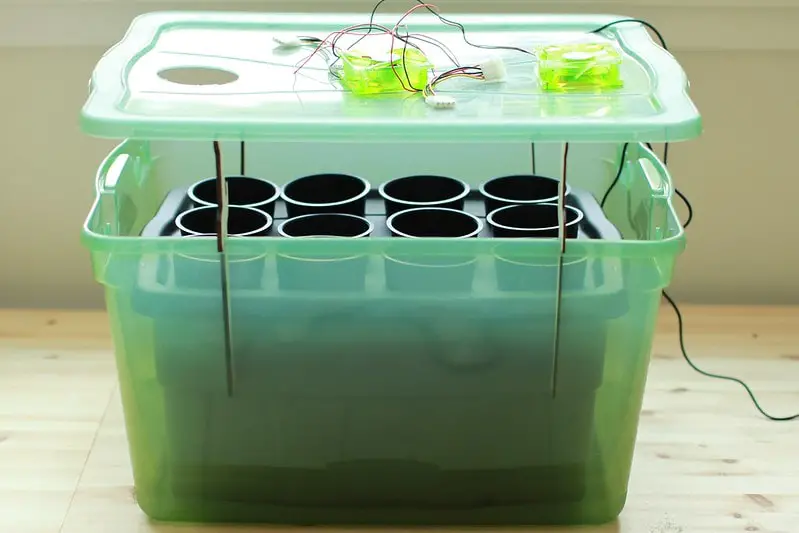
The main difference between established, automated aeroponic designs and fogponic designs is the nutrient solution delivery mechanism.
Fogponic units literally use fog to feed plant roots!
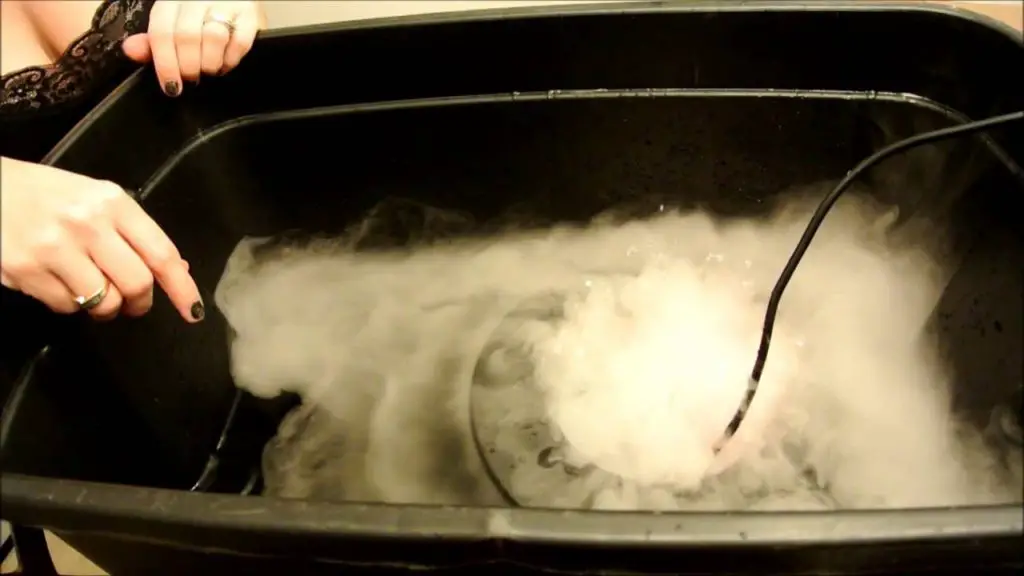
Advocates for Fogponics often point out that this highly diffuse mist – seen above – can provide an even finer source of nutrient solution than other aeroponic systems. Smaller droplets are absorbed faster, which means that plants can grow a little faster.
A proper fogponics system will provide plant roots with continuous nutrient solution mist that is between 5 – 40 micrometers per droplet.
This means that Fogponic systems use considerably less water and energy than traditional hydroponic systems.
Aeroponic systems are ideal for growing small plants but don’t expect to be growing any shrubs or trees with these units!
DIY Aeroponic System Designs
I want to make one thing very clear:
Most of the D.I.Y aeroponic growing system instructions that you find online are absolute garbage.
You have to remember that most active hydroponic designs are really difficult to build. One needs to have a certain level of engineering expertise to even try.
In order for an Aeroponic system to function properly, it must:
- Deliver nutrient solution to plant roots at an optimal delivery rate.
- Use a liquid solution that is rich in vital nutrients required for plant growth.
- Calculate the rate of nutrient solution consumption by plant roots. Also, you have to keep in mind, if you’re wanting to grow a variety of different vegetables, herbs, and spices, then your aeroponic design must calculate the differing consumption rates by plant species. For example, most vegetables require more nutrient solution than most herbs.
- Monitor humidity levels within the growing reservoir.
With that being said, there are a few designs that meet the criteria above, although it’s worth emphasizing that none of these D.I.Y designs will work as well as Aerogarden’s automated design.
- This Fogponics design uses Raspberry Pi – a small single-board computer – used for monitoring humidity.
- This homemade low budget aeroponics design is a great beginner’s aeroponics unit.
- This five-gallon design uses a hydroponic pump and seems to be pretty sound.

